main: February 2008 Archives
Someone, 20 years ago, suggested a discreet tattoo the site [sic, or pun] of which would alert the prospective partner to the danger of proceeding as had been planned. But the author of the idea was treated as though he had been schooled in Buchenwald, and the idea was not widely considered, but maybe it is up now for reconsideration.-- from "Killers at Large: AIDS Carriers and Their Victims" by William F. Buckley Jr., National Review Online, Feb. 19, 2005
Many traditional foodways are at risk, and this sharp site focuses on an important one: Save the Deli. Scroll down and check out Alan Richman's 2nd Avenue Deli blog review for GQ: he nails it (which means we agree).
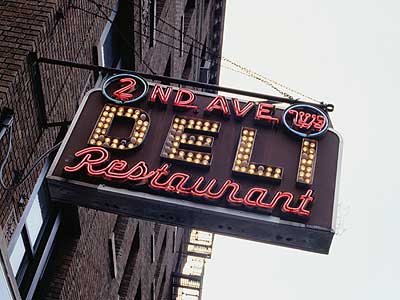
The old sign
A Tale of Meat
If you're not interested in a New York story, you can stop now. It may be annoying even if you are, because I'll be talking about a lifelong relationship with something a number of readers may never get to know -- which usually sounds like a brag.
No one ever said the 2nd Avenue Deli had the best pastrami. Most mavens pit Katz's on Houston Street ("Send a salami to your boy in the Army" -- the history-heavy sign dangles from the ceiling) against Langer's Delicatessen on South Alvarado in L.A. My own feeling is that, when you reach a certain, Shangri-La level of pastraminess, the sandwich directly in front of you is the best.
But yes, I cannot deny my fat expertise: For pastrami, it is indeed Katz's or Langer's, Langer's or Katz's. In some cases, the event defines the expert as well as the evaluation.

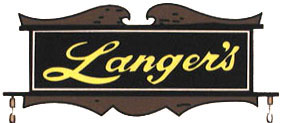
Two Critics
I went with my friend Daniel Young, a former restaurant critic of the New York Daily News, to the new 2nd Avenue Deli on East 33rd Street between Third Avenue and Lex. This establishment was founded on Manhattan's Second Avenue and 10th Street in 1954, which makes it a relative matzo-ball newcomer; little Jeff was already eating pastrami on seeded rye that year somewhere in Brooklyn, not far from Hymie's Highway Hi-grade Appetizers. I developed my career-enabling ability to differentiate flavors at that time by comparing one kind of mustard to another and quietly but precisely making my preference known. (It wasn't French's.)
The 2nd Avenue Deli moved reportedly because of an absurd rent increase, of the type that is forcing a nearby East Village trattoria, the excellent and hospitable Col Legno, to move -- or close! -- as well. Col Legno's still open, on East 9th Street between Second and Third; try the flask-cooked beans in olive oil with garlic and sage, fried artichokes, pappardelli with wild boar ragù, before they vanish.
Also, the deli's founder, Abe Lebewohl, was shot and killed in an early morning robbery in 1996, which made it hard to eat joyfully. Members of Abe's family opened the transplant in December.
Dan and I walked into a glass-walled anteroom. "Table or takeout?" was our efficient greeting by the man on the stool; when he got up to scout inside, he put his cup of something to drink on the seat. The deli doesn't take reservations, so we could employ Dan's trick: Don't arrive on the hour or half hour or even on the quarter. Come at eight minutes before, or 17 after, and you draw a better chance of being seated. (Sorry, Dan, I had to.)
Yet we still had to wait, so we stood as others came after us into the kosher aquarium, arranging their dignity and checking in. Whenever the interior door opened to let belching customers out, the hot-pickled-meat perfume from the jammed takeout counter flooded through, the best ad for "deli" ever created. (The counter is crowded because the servers pick up much of their orders there.) When we were kids, my brother and I wanted to bottle and sell that smell.
Suddenly I realized I was in for trouble: Whatever I actually ordered, I was about to be served a decent portion of mortality, pickle on the side.
Company
The stool-man made us an offer to share a table with another pair, and we agreed. The next two couples, offended, said no, but two guys bit, and in we went. The rectangular four-tops, arranged like booths, were tight as could be, and the fellows suggested that they take the outer seats because they'd be eating fast.
We thought: They have a curtain. What theater? It's far from Broadway. They don't look at all like a couple, or even gay, but who can tell.
Five minutes into their meal, one was trying to get the other to read a script by Al Carmines, the effervescent reverend who a while back ran the Village's Judson Poet's Theater -- I hoped it would be his 1973 musical hit, The Faggot. It was not hard to overhear.
Two critics, one meal, what to choose? I had eaten in the old version of this place dozens of times because I lived nearby and thought the food was rolling slowly downhill way before it closed. It took us just a few minutes to fashion a concentrated test: We would share a matzo-ball soup, then a corned beef sandwich and pastrami sandwich, flipping halves. Our mutual reviewing instinct demanded that we add an order of French fries.
Yes, I know, I know, the many touchstones we didn't touch.
As soon as the server realized we were not one party but a pair of deuces, she brought out mirror-images of the complimentary but mandatory plate of half-sours, sours, and pickled green tomatoes (two of each, two of everything, so no fighting); sides of the crunchy, not creamy, cole slaw, and something new for free: gribenes (GRIH-bin-iss), a monkey dish containing a scant dozen scraps of chicken skin fried in schmaltz. Bad even to think these resemble pork rinds. The usual recipe should include lookalike pieces of crispy onion, but I didn't taste any. I ate my few with appreciation more dutiful than passionate.
The broth of the soup was genuine but featureless. I sliced the light-beige tennis ball in half and gave it over. Not the worst, not the best ... but the cloud I was afraid of, a kind of time-transporting mist, began to form around my head. Then, bang on the table, meat and potatoes. We traded our almost identical sandwich portions carefully so the piles of ruddy slices wouldn't tumble. I saw Dan look at both and without hesitation choose corned beef first. His face disappeared.
Like him, I had no choice, and met my pastrami.
A Sandwich Life
There will always be those who want some kind of description that leads to a ranking, a rating. After we ate our sandwiches, Dan thought that the corned beef was better corned beef than the pastrami was pastrami, yet you could tell from his Cheshire grin that he was extremely pleased with both. Although the corned beef was well-colored (with saltpeter) and possessed the manifold edges of flavor that indicate a proper period of brining, we agreed it was slightly too mild.
I may have had better pastrami in my life, but sitting there I knew that I had crossed the snowy Himalayas and entered a serene, changeless realm where rating didn't matter. The breastlike softness of the bread as it chews into luxurious fat and the smoky, peppery, irreducible tang of transformed flesh ... and then the whole awakened, Mahler-like, by a clarion mustard ...
The pleasures of one's life are supposed to vary, to reflect and refine the protean person you are at each peak, significant time. But the pleasure of pastrami does exactly the opposite, forcing the older you, the older me, to acknowledge we are exactly the same ravenous, curious, sensuous beings we were at our first restaurant table, and will be until the final flecks of yellow and red are wiped from our lips.
Dan went uptown and I went down, hoping to meet again very soon.
* * *
For an automatic alert when there is a new Out There post, email jiweinste@aol.com.
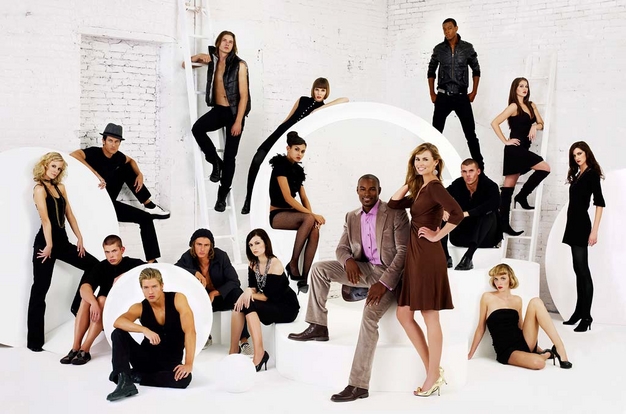
The two host-judges (foreground) and initial contestants on Make Me a Supermodel
Sincere congratulations, media scribblers, on a righteous strike.
During your absence, TV critics sneered at the temporary dominance of reality shows. But I had never understood their genre distinction, aware that those purportedly callow shadow-plays are scripted with the best of them. OK, semi-scripted. OK, employing a form of method acting, one without method.
I have praised the primitive, addictive, and unexpectedly sweet Project Runway in print before and, as it ends its fourth season, have no reason to recant. A fashion-design contest is the ploy, but the grabber is the obvious pleasure that men and women of all ages and sartorial preferences take in the making of something new to wear.
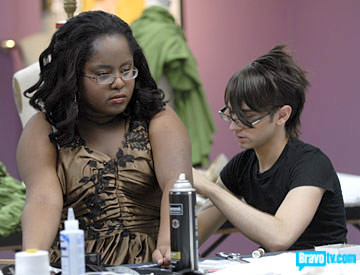
Project Runway contestant Christian (who may win) and his demanding prom-dress client
The Proms
Here's how a typical episode goes:
This week's design conundrum, a prom dress ... $100 and 20 minutes to run up and down the aisles of a photogenic bolt boutique and score the fabric of one's dreams ... two days to sketch and sew ... fit a high-school diva ... tears ... get her to makeup (sponsor one) and hair (sponsor two) ... second-act tears ... a teeny runway show ... "I was so relieved, my girl looked fierce" ... and finally, one guest and three regular judges choose their best and worst, embarrassing winners and losers both with expert clichés whose vapidity is surpassed only by their inconsistency.
Reality? The pictured emotions may be suspect, but emotions on the sofa at home are real as the sweatshops humming far underground. I dare you to be unmoved. (How many times have I lost such a dare?) And tell me, where can you find another program dedicated to the on-site creation of beauty?
Top Chef, you say, also on Bravo? I feature the appeal of food as much as the next aesthetic consumer, but that program hasn't found a way to get beyond knife glitz and schoolyard bullying.
Model Tease
I also can't get enough of the new runway show Make Me a Supermodel. ("Make me a malted." "Poof, you're a malted.") The youthful male and female contestants flown from Plano, Texas, and Nashville, Tennessee (yes, he's the married twink prison guard) to share bedrooms in a Manhattan townhouse as they compete for the top spot are cute as glandular buttons. But they are "playing themselves" on so many levels of vacuous, Web-teen artifice, in front of so many simultaneous cameras, mirrors, and lights, that the result could have been put together by the Writer's Guild team of Albee-Pinter-Ionesco.
Somehow, a bracing bit of charm squeaks through -- and this week, for the first time, yours truly compromised his hard-won critical integrity by voting via computer for one of the three threatened candidates he most wanted to keep in the running. (It's gay-guy Ronnie, the only out contender. He's not doing all that well because the judges keep saying his look is too "All-American." Irony is not the show's strongest suit.)
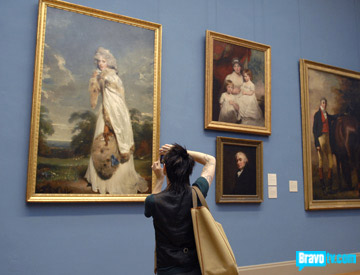
A Runway contestant -- Christian again, who may win -- seeking inspiration
Both Paintings and Clothing Are Hung
In case you think you have reached the very bottom of the cultural barrel with these televised treats, you're in for a surprise if you click here. As you see, five Project Runway finalists are being led by mother hen Tim into the recently refurbished, overly praised Greek and Roman Galleries of the Metropolitan Museum of Art. It's early morn and the place is empty, just like in a movie -- what a nice museum, to let them in before everyone.
"I've never been here," says sloe-eyed, open-faced Rami, a 31-year-old, Ramallah-born fashion designer from California, without a smidgen of bourgeois embarrassment. Each of the troupe is given a little silver camera and asked to choose an artwork in Antiquities, Euro Painting, or the Temple of Dendur that would "inspire" his or her next creation.
Rami is known to like draping, so, big surprise, he shoots Aphrodite. Soon there's an online vote about "Rami's draping addiction" -- 72 percent of respondents think he should drop the drapes. Who says classical education is dead?

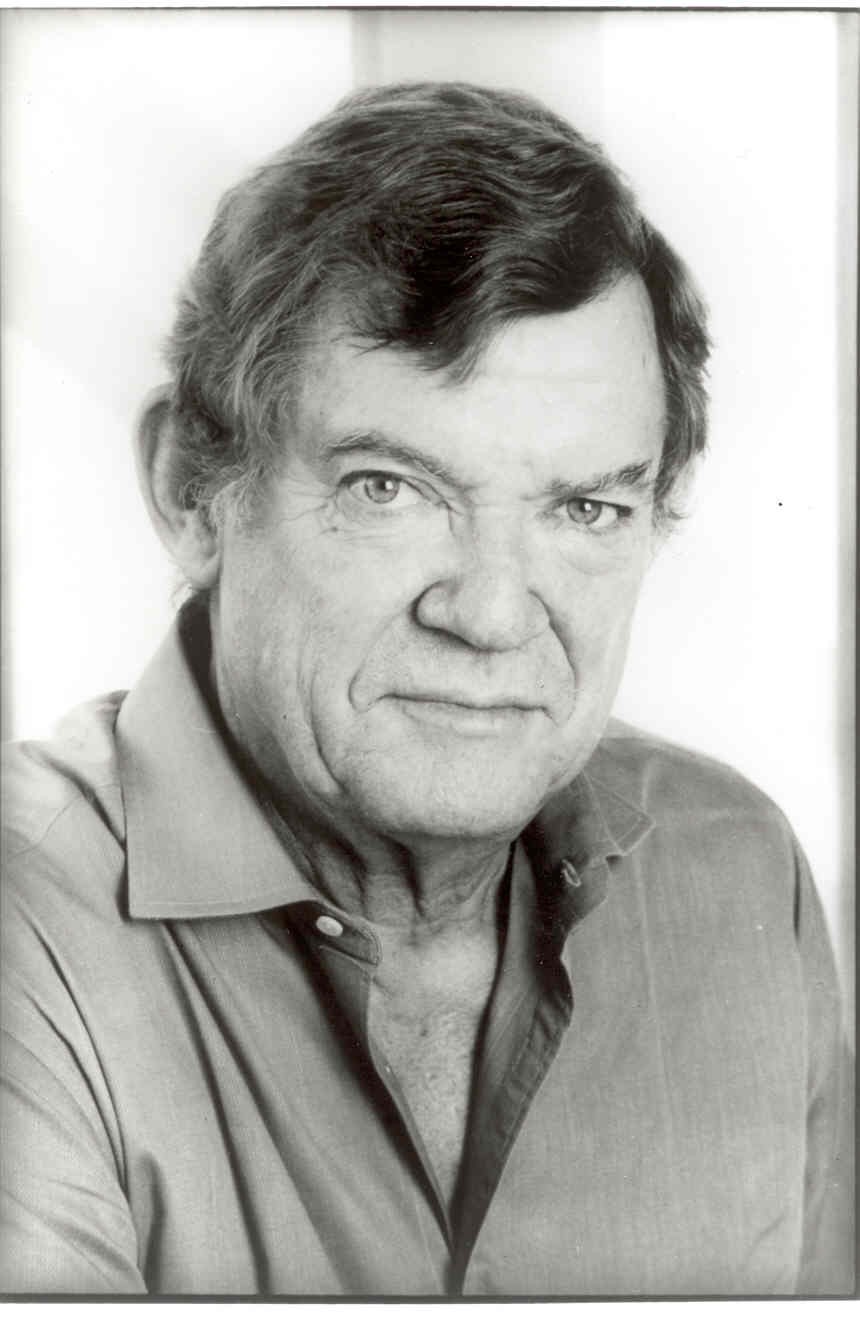

Make Me a Superartcritic's ideal panel
Critics Next
I've been waiting for public television to roll out (on square wheels) its version of reality, but so far nothing has appeared. Variety recently reported that Sarah Jessica Parker is getting ready to pitch a show in which tyro artists would compete to make the best (most salable?) artwork. And the judges would be ....
But that reality sounds too real for PBS, so I suggest moving it up a notch and offering the gouty network a show in which I myself would be pleased to have a part: Make Me a Superartcritic.
Scour the nation for 10 fresh, aspiring, small-town talents who have dreamed about the glamour, recognition, wealth, and lobster-filled summer junkets that make a career as a famous art critic the most gratifying goal anyone might imagine. Set them up in underheated apartments at least two bus and/or subway connections from New York's Chelsea, epicenter of the international art world.
Provide meals for five days a week and see if they can cadge the rest at openings or parties.
It should be fun. Throw the kids out each episode to see a few shows, and have them come back with their best short, medium, and full-length reviews. Have them face a gantlet of bloodless editors at, say, Art in America. Have them negotiate with gallery bigwigs about that ethically delicate but lucrative catalog.
And the panel of judges? Perhaps in this case a mix: of distinguished artists, critics, and dealers. To start, how about Julian Schnabel (now that he needs movie critics, not art ones, he can be objective), Robert Hughes (cameras make him look better, not worse), and Leo Castelli (he's dead, but that won't matter). And for the first guest expert, who can better ascertain the true value of art and the importance of criticism than Sotheby's soigné auctioneer, Mr. "Rockefeller Rothko" himself, Tobias Meyer?
Yes, they're all males, males of a certain color, but this is the art world.
I think we could have a hit.
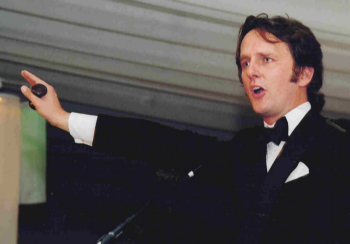
"Sold!"
* * *
For an automatic alert when there is a new Out There post, email jiweinste@aol.com.
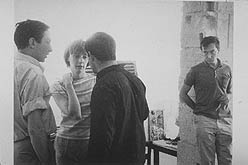
"Up-and-coming studs" Bob, left, and Jasper, far right, just before their breakup in 1961 (from "The Art of Code")
A piece of canvas covers its surface like a blanket except for portions at the bottom, where Tennyson's name appears in murky stenciled letters, and the top is vertically bisected, suggesting two pillows. Mr. Rondeau sees the work as a response to "Bed," which Mr. Johns's close friend at the time, Robert Rauschenberg, painted three years earlier on the quilt and sheets of his actual single bed.
-- Roberta Smith, in a New York Times review of the "Jasper Johns: Gray" show, just opened at the Metropolitan Museum of Art, Feb. 8, 2008
Like Rauschenberg, whom the artist befriended in 1954, Mr. Johns, working somewhere between painting and object, incises his pictures; and he collages things, images, and everyday objects -- including newspapers, rulers, brooms, metal cans, and rope, as well as cast body parts -- to his canvases.
-- Lance Esplund, in a New York Sun review of the same show, Feb. 7, 2008
Just when enough seems enough, we land in 1961, the year of his discontent. Wall text explains this was "the year that Johns's influential relationship with the artist Robert Rauschenberg dissolved." We hardly need the information to know that Johns was upset (he himself has said "the mood changes").
-- Terry R. Myers, in a Time Out: Chicago review of the "Gray" show at its originating venue, the Art Institute, Nov. 15, 2007
Don't skip the wall labels at the Met's "Jasper Johns: Gray" blockbuster. We don't mean the text asserting that the show is moody, intellectual, and groundbreaking -- which it, surprisingly, is. We mean the tiny letters that tell you who owns what's on the walls.
While such info is usually hush-hush -- "Private collection" is the norm -- for this show, collectors seem to be eager to come out of the closet as Johns fans. Robert Rauschenberg owns the artist's 1960 silvery Flag.
-- Alexandra Peers, in New York Magazine's "Vulture," Feb. 6, 2008
Although the artists remain circumspect on this point, there is reliable evidence that for over six years Jasper Johns and Robert Rauschenberg were lovers. For both artists, it was probably the most serious and intense relationship of their lives, a relationship which was to have a profound effect on the work of each of them at a critical moment in their development. When they finally split up in 1961, the after-effects were so powerful that both artists left New York for their native South, changed their pictorial styles radically, and neither saw nor spoke to one another for a decade or more.
-- Jonathan D. Katz, from "The Art of Code," an essay in Significant Others: Creativity and Intimate Partnership, 1993
Robert Rauschenberg: I'm not frightened of the affection that Jasper and I had, both personally and as working artists. I don't see any sin or conflict in those days when each of us was the most important person in the other's life.
Interviewer: Can you tell me why you parted ways?
RR: Embarrassment about being well known.
Interviewer: Embarrassment about being famous?
RR: Socially. What had been tender and sensitive became gossip. It was sort of new to the art world that the two most well-known, up-and-coming studs were affectionately involved.
-- from "The Art of Code"
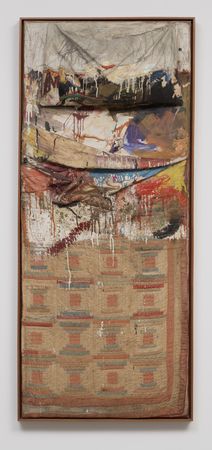
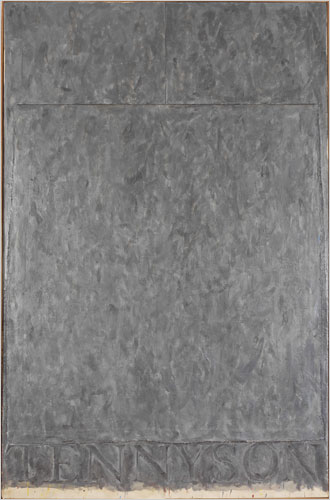
Robert Rauschenberg, Bed, 1955. Jasper Johns, Tennyson, 1958.
* * *
For an automatic alert when there is a new Out There post, email jiweinste@aol.com.
Blogroll
More a cracker than a roll, but 10 for the moment:
Robin Holland
Studies in Crap
Obit
Ehrensteinland
Artopia
Matthew Gallaway
David Lida
Young and Foodish
C-Monster
Pam Rosenthal
